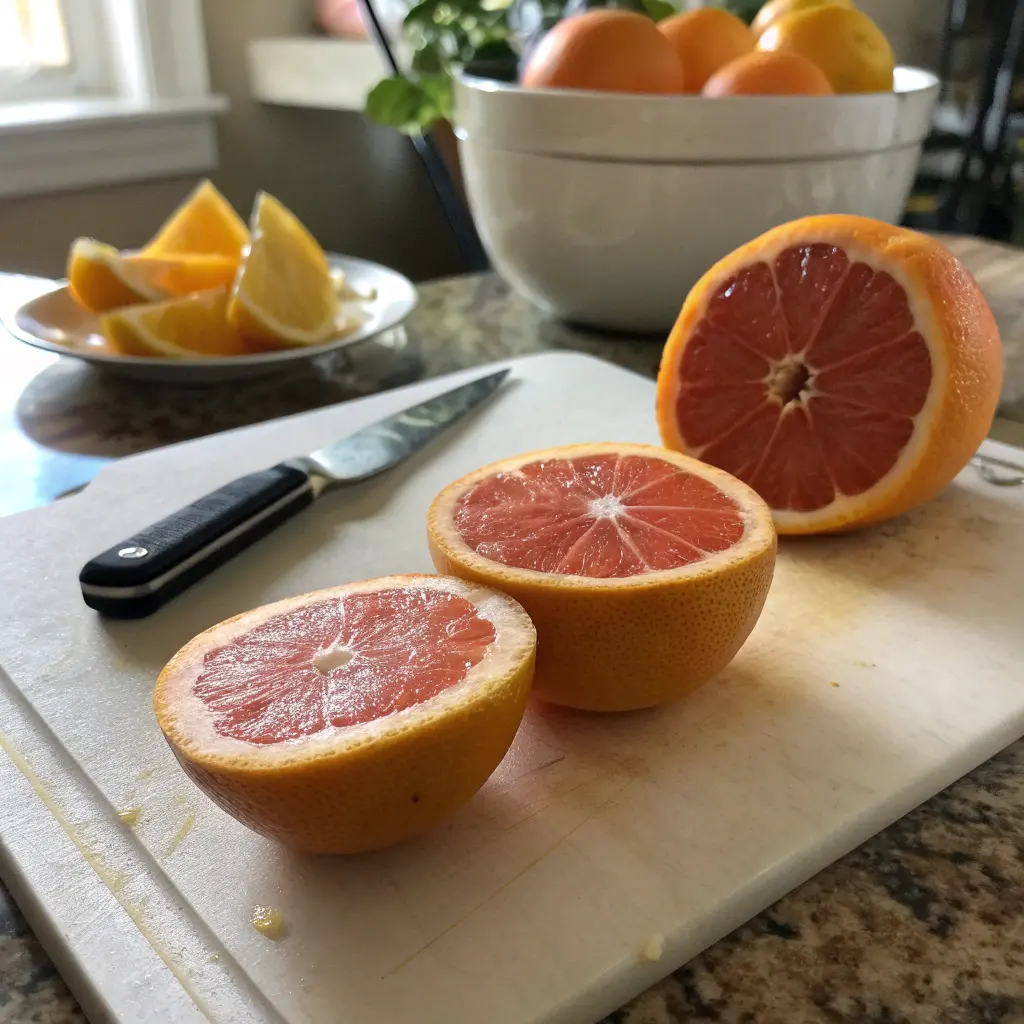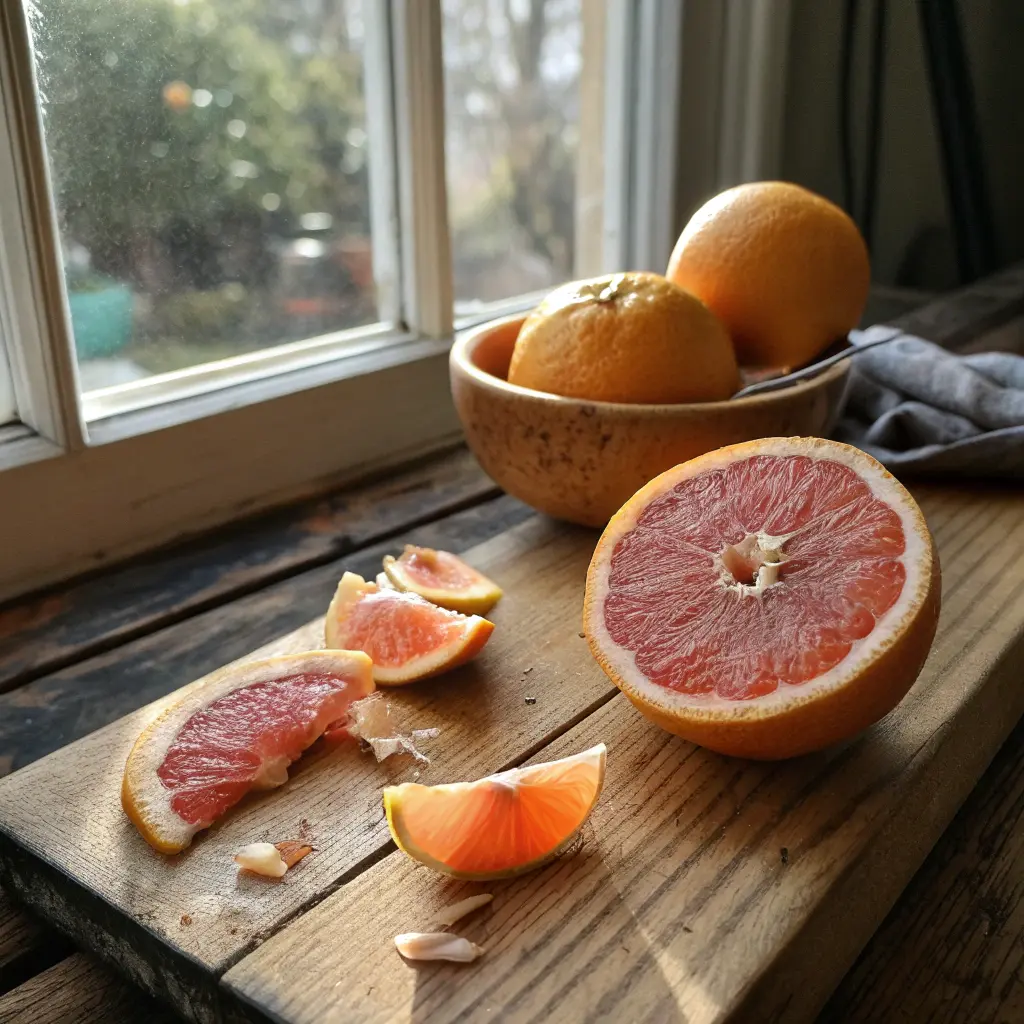What Are Cara Cara Oranges?
Cara Cara Oranges are a special type of navel orange that stands out for its vibrant pinkish-red flesh.
These oranges were first discovered in the mid-1970s at Hacienda Cara Cara in Venezuela, hence the name.
Compared to standard navels, cara cara oranges have a sweeter, less acidic taste, often described as having a hint of cranberry or berry-like undertones.
Origins & History of Cara Cara Oranges
Discovered by accident, this citrus variety quickly gained popularity once people realized how unique it is in flavor and color.
They made their way to the United States in the 1980s, when orchard owners in California and Florida began growing them for commercial distribution.
Over time, this fruit has become a favorite among citrus enthusiasts who crave something beyond the traditional orange.

What Makes Cara Cara Oranges Different from Navel Oranges?
- Color: While navel oranges have orange flesh, these fruits reveal a striking pinkish-red interior.
- Flavor: They offer a rich, sweet taste with subtle berry notes.
- Lower Acidity: This results in less tang and a smoother citrus bite.
Unique Characteristics – Color, Flavor, and Texture
- Color: Ranging from light pink to deep salmon.
- Flavor: Sweet and bright, with a mild hint of cherry or berry.
- Texture: Similar to classic oranges, yet sometimes a bit more delicate.
This citrus marvel often becomes a conversation starter at breakfast tables, fruit stands, or farmers’ markets. People can’t help but notice the lovely hue hidden beneath the peel.
Nutritional Benefits of Cara Cara Oranges
- Vitamin C and Immune System Boost
- Like other citrus fruits, they excel at delivering vitamin C.
- One medium fruit can offer a significant portion of the recommended daily intake, supporting your immune function to help fight off common colds and maintain overall health.
- Antioxidants for Skin and Eye Health
- The pinkish hue is partly due to lycopene, a powerful antioxidant also found in tomatoes and watermelons.
- Alongside beta-carotene, these antioxidants contribute to skin radiance and eye health. Regular consumption can help protect cells from oxidative stress.
- Low-Calorie, High-Fiber Benefits
- For those watching their calorie intake, these oranges make an excellent snack.
- Averaging around 80–90 calories per fruit, they contain dietary fiber that aids digestion, helps you feel full longer, and supports gut health.

Comparing Cara Cara Oranges vs. Other Citrus Fruits
- Blood Oranges: Have a deep red hue and are more tangy than sweet.
- Navel Oranges: Feature a classic orange color and are typically more acidic.
- Mandarins: Are smaller, easier to peel, and have a slightly different flavor profile.
Among these, cara cara oranges stand out for their pastel interior, sweet taste, and moderate acidity.
How to Choose the Best Cara Cara Oranges
Signs of Ripeness – Color, Weight, and Firmness
When shopping, look for bright orange skin with minimal blemishes. Slight variations in peel color are normal, but avoid any with large soft spots or mold.
A heavy fruit often indicates juiciness, while a slight give under gentle pressure suggests ripeness.
How to Store Cara Cara Oranges for Maximum Freshness
Store them in the fridge’s crisper drawer if you’re not consuming them within a few days. The cooler temperature prolongs their shelf life, keeping them juicy and crisp, though room temperature is acceptable for short-term storage of 2–3 days.
How Long Do Cara Cara Oranges Last?
- At Room Temperature: Approximately 3–5 days
- In the Fridge: Up to 2 weeks
For extended storage, check them often and separate any that start to spoil.
Best Ways to Enjoy Cara Cara Oranges
Eating Fresh – The Perfect Healthy Snack
Peel and eat them fresh to appreciate their sweetness and stunning color once the rind is removed.
Fresh Juice for a Refreshing Drink
Juice these oranges for a morning beverage. Their rosy hue looks elegant, and the sweet-tang balance tastes incredible. Combine with other fruits—like strawberries or pineapple—for a tropical twist.
Adding to Smoothies & Breakfast Bowls
Incorporate orange segments into your smoothie or top your morning oatmeal with diced pieces. This brightens your breakfast in both flavor and appearance.
In Salads & Savory Dishes
Segment the fruit to toss into green salads, especially those with spinach, arugula, or kale. The sweet citrus note balances out tangy dressings or bitter greens, and it pairs well with proteins in savory dishes like chicken or shrimp stir-fries.

Popular Cara Cara Orange Recipes
Cara Cara Orange Juice Recipe
Ingredients:
- 4–5 Cara Cara Oranges
- Optional sweetener (like honey) if needed
Instructions:
- Peel the oranges, removing as much pith as possible.
- Juice them using a citrus juicer or blender.
- Taste. If you prefer a sweeter profile, add a little honey.
- Serve chilled or over ice.
Cara Cara Citrus Salad with Honey Dressing
Combine segments of Cara Cara Oranges, grapefruit, and mandarins. Drizzle with a honey-lime dressing, top with fresh mint, and sprinkle crushed pistachios for crunch.
Roasted Cara Cara Orange Chicken
Marinate chicken in fresh orange juice, garlic, rosemary, and a bit of olive oil. Roast until golden, basting occasionally with the marinade for a citrus-infused main course.
Cara Cara Orange Sorbet
Blend fresh Cara Cara Orange juice with sugar or a sweetener, freeze in an ice cream maker. The result is a pastel-orange sorbet, tangy yet sweet, perfect for dessert.
Cooking and Baking with Cara Cara Oranges
Can You Use It for Baking?
Yes. They excel in muffins, breads, or cakes that need a citrus spark. Their color doesn’t always dominate in baked goods, but the flavor definitely does.
Best Ways to Zest and Juice Cara Cara Oranges
- Zest: Use a microplane or zester to remove only the orange outer rind. Avoid the white pith, which tastes bitter.
- Juice: Roll them on the counter before cutting to release more juice.
Savory vs. Sweet Recipes – Best Pairings
- Savory: Combine with herbs like thyme or rosemary, pair with poultry or pork.
- Sweet: Use in cakes, cookies, jams, or glazes for an uplifting citrus taste.
Cara Cara Oranges vs. Blood Oranges – What’s the Difference?
Flavor Comparison
- Cara Cara: Sweeter, with mild berry hints.
- Blood Oranges: Often tangier, more intense citrus flavor.
Nutritional Differences
Both are high in vitamin C and anthocyanins (for blood oranges) or lycopene (for Cara Cara). Each has antioxidant benefits.
Which One Is Better for Cooking?
Personal preference rules. If you want bright sweetness, choose Cara Cara Oranges. For tangy, deeper color, blood oranges might be your pick.
Creative Uses for Cara Cara Oranges
Homemade Cara Cara Orange Marmalade
Simmer segments (with some peel) in sugar and water until thick. Spread on toast or serve with cheese boards for a sweet-citrus accent.
Infused Water & Detox Drinks
Slice Cara Cara Oranges and add to water pitchers with cucumber or mint. The subtle flavor encourages hydration, plus it looks pretty in a glass.
Cocktail & Mocktail Ideas
Mix fresh orange juice or zest in cocktails like margaritas, mimosas, or sangrias. Non-alcoholic spritzers also benefit from the sweet tang of Cara Cara Oranges.
Where to Buy Cara Cara Oranges?
Best Seasons to Find Them in Grocery Stores
Peak season usually runs from December to April in North America. During these months, you’ll find them easily in produce aisles. Out of season, you may rely on imports or pay a premium.
Buying Organic vs. Conventional Cara Cara Oranges
If you’re concerned about pesticide residues, consider organic Cara Cara Oranges. However, conventional ones can still be high quality. Always rinse the peel under water regardless.
Can You Grow It at Home?
Yes—if you live in a warm, citrus-friendly climate (like USDA zones 9–11). Dwarf trees can thrive in large containers. Patience is key; it might take a few years before bearing fruit.
FAQs
What do Cara Cara Oranges taste like?
They’re sweet with subtle hints of berry or cherry, less acidic than standard oranges.
Are Cara Cara Oranges the same as Blood Oranges?
No. Blood oranges have deeper red flesh and a tangier taste, while Cara Cara Oranges have pinkish-red flesh and sweeter notes.
How do I store It properly?
Keep them in the fridge’s crisper drawer for up to two weeks or at room temp for ~3–5 days.
Can you freeze Cara Cara Orange juice?
Yes. Freeze in ice cube trays, then transfer to freezer bags. Great for flavoring drinks or sauces.
Are Cara Cara Oranges good for weight loss?
They’re low in calories and high in fiber, so they can be part of a healthy weight-loss diet.
What’s the best way to use Cara Cara Orange zest?
In baked goods, dressings, or marinades. The aromatic oils can enhance both sweet and savory dishes.
Final Thoughts
Cara Cara Oranges bring a unique combination of sweet flavor, lower acidity, and a gorgeous pinkish hue to your table.
Their versatility extends from fresh eating to a wide range of recipes—salads, marinades, juices, and beyond. If you haven’t yet tried these vibrant citrus gems, let their bright color and refreshingly sweet taste entice you.
Pick up a few at your local market and experiment with ways to incorporate them into daily meals, from morning juices to late-night desserts. For an extra touch of sweetness, try using demerara as a finishing accent.
The more you explore, the more you’ll appreciate just how special Cara Cara Oranges can be.

